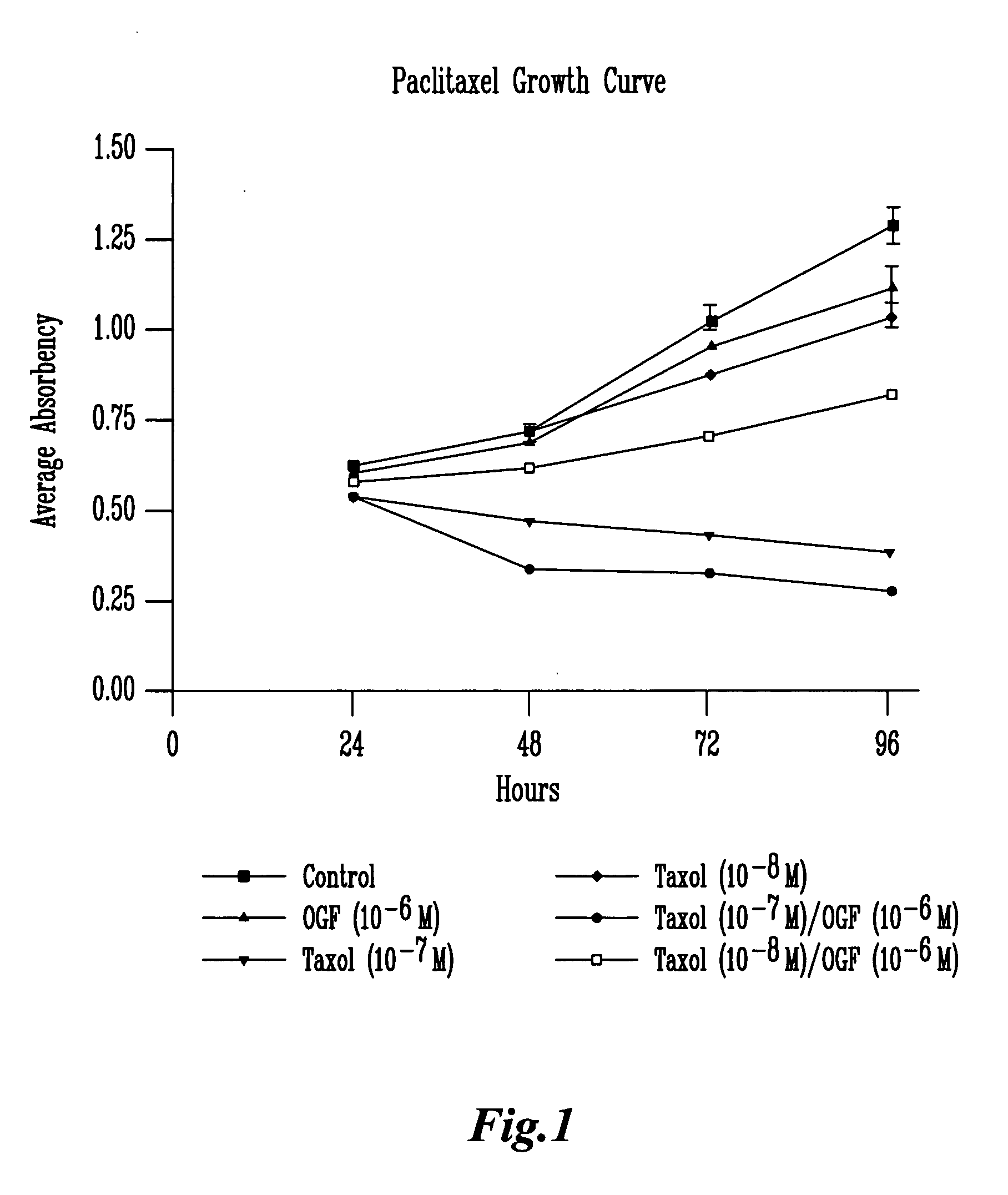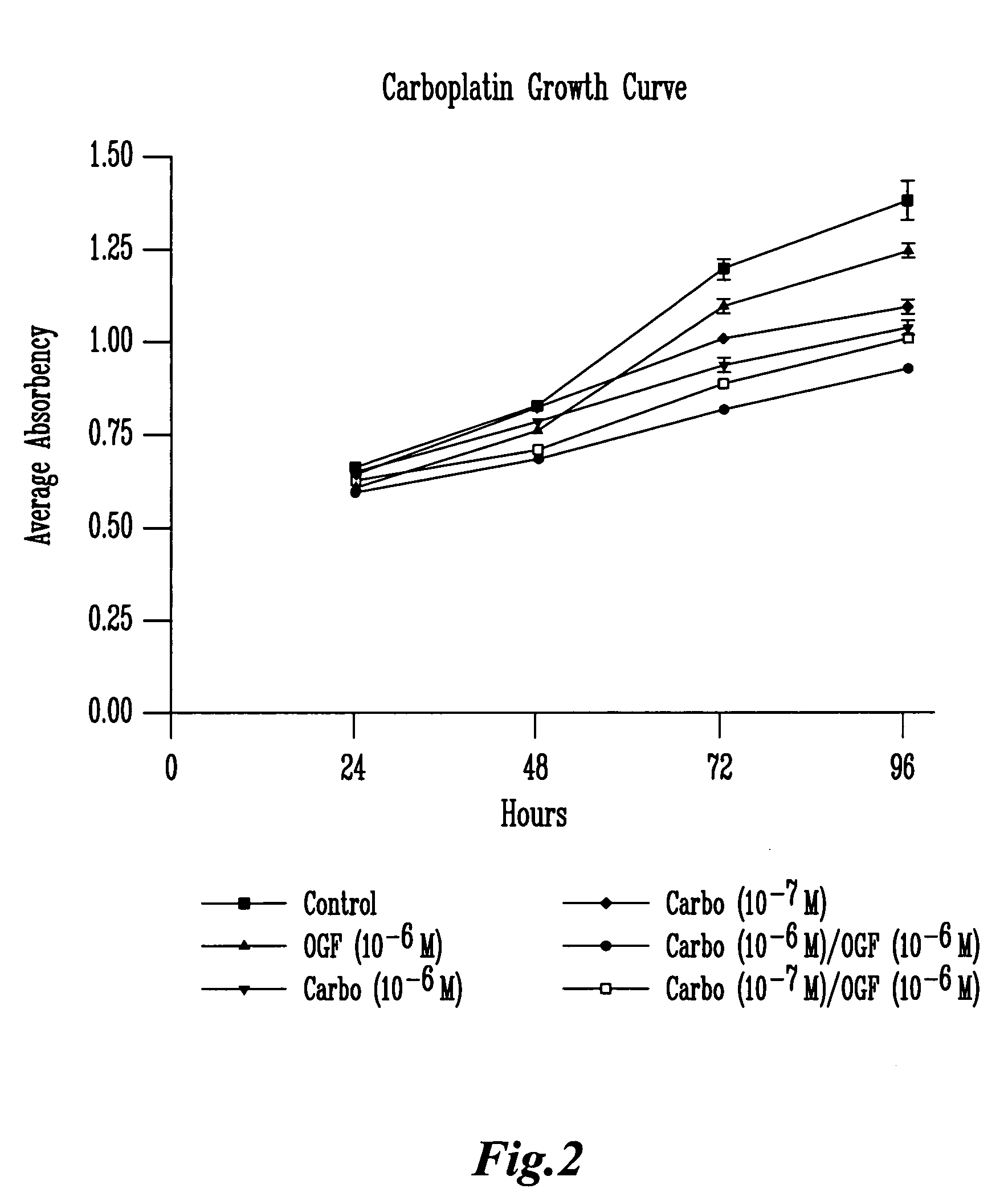Combinatorial therapies for the treatment of neoplasias using the opioid growth factor receptor
a technology of neoplasia and growth factor, applied in the field of therapeutic formulations, can solve the problems of 50% chance of recurrence of scchn, poor prognosis of these individuals, and profound challenges in the prevention, diagnosis, prognosis and treatment of pancreatic cancer, so as to reduce the toxicity of the treatment
- Summary
- Abstract
- Description
- Claims
- Application Information
AI Technical Summary
Benefits of technology
Problems solved by technology
Method used
Image
Examples
example 1
Combination Therapies on the SCC-1 Cell Line
1. Growth Curves—SCC-1 Cell Lines
[0089] The growth of cells as represented by absorbency taken at 450 nm from the cell proliferation assay plotted against time was the standard format for presenting the effects of different drugs on SCC-1 or MiaPaCa-2 cells. Cells were counted using a standard MTT assay. In general, each data point represents the average absorbency taken from 10 wells / treatment; error bars represent the S.E.M.
[0090] a. Paclitaxel Treatment
[0091] The results illustrated in FIG. 1 and Table I examine the addition of paclitaxel (Taxol) and / or OGF to SCC-1 cells. Throughout the 4-day growth curve, statistical analysis (ANOVA) revealed that OGF (10−6 M) alone inhibited growth at 48, 72 and 96 hours decreasing cell number from control levels by 11.9, 6.7, and 12.7%, respectively. Paclitaxel at a concentration of 10−7 M inhibited cell growth at 24, 48, 72, and 96 hours decreasing cell number from controls by 14.2, 34.4, 58, ...
example 2
SCC-1 Tumor Appearance and Growth
[0098] All mice that were injected with SCC-1 cells developed tumors. On day 13 after tumor cell inoculation, 75% of mice, 66% of paclitaxel treated mice, and 58% of paclitaxel / OGF treated mice had tumors. When examining latency to a visible tumor, control mice developed visible, but not measurable tumors within 7 days of tumor cell inoculation. Paclitaxel and paclitaxel / OGF mice also developed visible tumors within the same 1-week time frame while OGF mice developed tumors within 11 days, exhibiting an approximate 4-day delay in visible tumor development (p3) tumors displayed an analogous pattern to the latency for visible tumors where control, paclitaxel, and paclitaxel / OGF groups had measurable tumors within 2 weeks of tumor cell inoculation while the OGF group developed measurable tumors within 17 days, although this difference was not significant from control values.
[0099] Tumor dimensions were recorded every day beginning on the day that the ...
example 3
Combination Therapies on the MiaPaCa-2 Cell Lines
[0101] The results illustrated in FIG. 7 examine the addition of 5-FU and / or OGF to MiaPaCa-2 cells. Throughout the 4-day treatment period statistical analysis (ANOVA) revealed that the OGF (10−6 M) alone significantly inhibited growth at 24, 48, 72, and 96 hours with decreases in cell number from controls of 7.1, 7.0, 6.9 and 14.2%, respectively. 5-FU at a concentration of 10-5 M inhibited cell growth at 48, 72, and 96 hours decreasing cell number by 26.0, 30.1, and 36.4%, respectively relative to controls. 5-FU at a concentration of 10−6 M also inhibited growth at 48, 72 and 96 hours decreasing cell number relative to controls by 12.7, 10.8 and 15.2%, respectively. When 5-FU (10−5 M) was combined with OGF (10−6 M), growth inhibition was observed at 24, 48, 72, and 96 hours resulting in decreases in cell number from sterile water treated controls of 21.5, 35.7, 39.7, and 47.4%, respectively. When 5-FU (10−6 M) was combined with OGF ...
PUM
| Property | Measurement | Unit |
|---|---|---|
| Time | aaaaa | aaaaa |
| Time | aaaaa | aaaaa |
| Time | aaaaa | aaaaa |
Abstract
Description
Claims
Application Information
 Login to View More
Login to View More - R&D
- Intellectual Property
- Life Sciences
- Materials
- Tech Scout
- Unparalleled Data Quality
- Higher Quality Content
- 60% Fewer Hallucinations
Browse by: Latest US Patents, China's latest patents, Technical Efficacy Thesaurus, Application Domain, Technology Topic, Popular Technical Reports.
© 2025 PatSnap. All rights reserved.Legal|Privacy policy|Modern Slavery Act Transparency Statement|Sitemap|About US| Contact US: help@patsnap.com



